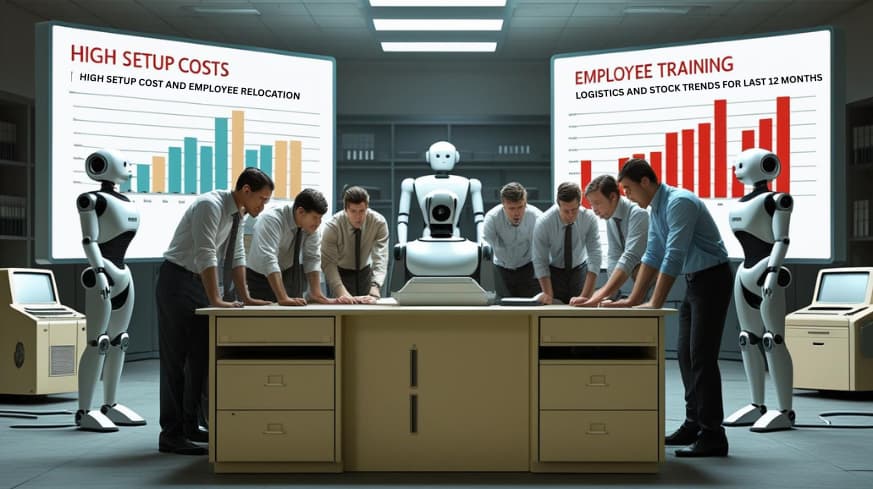

Getting goods delivered on time, keeping prices down and avoiding delays are the three main objectives in logistics. Meeting up with all these goals at the same time is difficult. Delivery routes often change. Warehouses may be overcrowded and drivers are delayed. Besides that, there can be lag in inventory systems.
That’s where AI logistics automation comes in, a smart way to address confusion and complexity.
AI is no longer a thing in the future. It is being used already and it is changing how goods are stored, packed, shipped and tracked.
AI logistics automation works faster than humans, makes fewer mistakes and never needs to take breaks. The big question now is: Is the logistics industry ready to use AI?
Let’s talk about what AI-driven automation means for logistics. Where it is already working, and what roadblocks still lie ahead. We’ll learn how companies can start utilizing it today.
AI logistics automation refers to the application of smart computer systems to make a range of logistics decisions without people managing every single stage.
AI uses old data which helps to understand the current situation and makes quick decisions that can reduce costs and improve efficiency.
For example:
AI logistics for returns automation is helping brands manage reverse shipments faster and cheaper. Unlike traditional software solutions, AI improvements get better over time. Each shipment, delivery or return increases the AI’s intelligence.
![]()
Let us review examples of AI common applications that have a clear impact on logistics:
AI is able to review thousands of delivery points simultaneously, and identify the fastest method in seconds. AI looks at real-time operation, checks for traffic, road closures and weather-related delays to avoid unnecessary delivery delays.
This means:
Tools like Google’s OR-Tools or Route4Me already use this.
Ai-driven logistics automation reduces human error and speeds up warehouse operations. In modern warehouses, AI helps:
This reduces human error and ensures popular products are never out of stock.
Conveyor belts and robotic arms powered by artificial intelligence help sort packages by their dimensions, and destination. They also pack products in the smallest boxes possible to save shipping costs. This will reduce material waste while speeding up the workflow in a warehouse.
AI is able to analyze driving styles . Also breakdown history to predict when a truck is due for maintenance. This allows companies to foresee and address delivery stoppage issues. It also reduces repair costs and can prevent costly off-road delays.
With AI, customers get more than a tracking link. They receive smart updates like:
These small touches build big trust.
Now for the big question: Is the logistics industry prepared for AI automation?
Benefits of Ai in logistics include real-time tracking, smarter routing, and cost savings. So, many established corporations already have AI logistics automation in place to be competitive:
Smaller logistics companies are also using AI tools in the form of chatbots for customer service, invoice processing, and tracking fuel.
So yes, currently, there’s a clear shift happening because companies want to spend less and work fast.

Not every company is ready to go all-in. Here’s why:
So some companies will need time and training to fully shift while the industry is ready in many ways.
If you’re wondering whether AI is worth the cost, here’s what AI logistics automation actually saves or improves:
For example, a delivery company using AI to plan 1,000 deliveries per day can save hundreds of liters of fuel per month, just from better routing.
You don’t need to change everything overnight. Here’s a simple step-by-step path:
Pick one thing like route planning, warehouse stocking, or delivery alerts. Don’t try to automate everything at once.
There are many ready-made tools like:
Start with software-as-a-service (SaaS) tools that offer low-cost monthly plans.
Allow your employees to learn how to use AI tools by navigating simple dashboards. The objective is to make their job easier, not more difficult.
Compare time saved, money saved, or errors that were avoided. This will help illustrate the concrete value of AI.
When you start to see success, consider trying AI in other areas such as billing, safety, or customer support.
WebOsmotic helps logistics companies use AI in a simple and stress-free way. Whether you run a small delivery business or a large shipping company, we can help you work faster and smarter with the power of AI. Our goal is to make your job easier, not harder.
You don’t have to replace your current software. We design AI tools that connect easily with what you already use. This includes: smart dashboards that help you see what’s working and what needs to improve. No complex setup. No confusion. Just simple tools that help you move ahead.
WebOsmotic builds automation systems for every part of your work. This includes managing your warehouse and giving customers real-time updates. Our tools also create driver logs and handle customer queries through AI-powered bots. That means fewer delays and fewer mistakes.
You don’t need to be a tech expert to use AI. If you know your goals, we’ll take care of the rest. Our team will set up and manage everything. You can focus on running your business while we help you get faster deliveries and happier customers.
AI logistics automation is not here to take jobs. It is here to make work easier and smarter. It helps drivers reach faster, helps warehouses store goods better, and helps managers track everything more clearly. It also helps companies grow stronger by saving time and money.
The future of logistics will use smart machines, real-time data, and human skills together. This change is already happening.
The only question is are you ready for it? If you work in logistics and want to plan better and reduce costs, then AI is your next step. You don’t have to figure it out alone. Let WebOsmotic guide you. We make AI simple and useful for every logistics business.